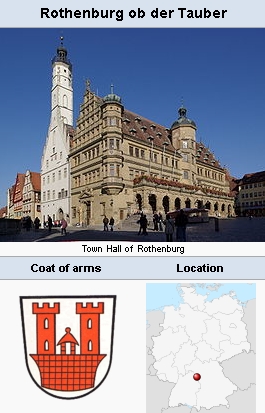Difference between revisions of "Rothenburg ob der Tauber (Freistaat Bayern, Germany)"
| [checked revision] | [checked revision] |
m (Text replace - "Karlsruhe; Schneider, 1913-1967: v. III" to "Karlsruhe: Schneider, 1913-1967: v. III") |
m (Text replace - "<em>Mennonitisches Lexikon</em>, 4 vols. Frankfurt & Weierhof: Hege; Karlsruhe: Schneider, 1913-1967: v. III," to "''Mennonitisches Lexikon'', 4 vols. Frankfurt & Weierhof: Hege; Karlsruhe: Schneider, 1913-1967: v. III,") |
||
| (One intermediate revision by the same user not shown) | |||
| Line 1: | Line 1: | ||
| − | [[File:Rothenburg.jpg|300px|thumb|right|''Source: [http://commons.wikimedia.org/wiki/Main_Page Wikipedia Commons]'']] Rothenburg ob der Tauber, a town (population in 1959, 11,200; 11,226 in 2006; coordinates: <span title="Latitude">49° 22′ 37.88″ N</span>, <span title="Longitude">10° 10′ 44.18″ E</span>) in [[Bayern Federal State (Germany)|Bavaria, Germany]], in which there were a few [[Anabaptism|Anabaptists]] in the early 16th century. As an imperial city since 1172 it had some rural territory attached to it. [[Karlstadt, Andreas Rudolff-Bodenstein von (1486-1541) |Karlstadt]]'s presence here from December 1524 to the end of May 1525 had some influence. Anabaptist preachers and teachers penetrated Rothenburg territory in 1527/28 from | + | [[File:Rothenburg.jpg|300px|thumb|right|''Source: [http://commons.wikimedia.org/wiki/Main_Page Wikipedia Commons]'']] Rothenburg ob der Tauber, a town (population in 1959, 11,200; 11,226 in 2006; coordinates: <span title="Latitude">49° 22′ 37.88″ N</span>, <span title="Longitude">10° 10′ 44.18″ E</span>) in [[Bayern Federal State (Germany)|Bavaria, Germany]], in which there were a few [[Anabaptism|Anabaptists]] in the early 16th century. As an imperial city since 1172 it had some rural territory attached to it. [[Karlstadt, Andreas Rudolff-Bodenstein von (1486-1541) |Karlstadt]]'s presence here from December 1524 to the end of May 1525 had some influence. Anabaptist preachers and teachers penetrated Rothenburg territory in 1527/28 from nearby Windsheim, among them [[Nespitzer, Georg (16th century)|Georg Nespitzer]], a weaver of Passau, George Utz, a dyer of Munich, and Marx Maier from Alt-Erlangen. In 1529 several Anabaptists were arrested in Rothenburg—Hans Bassauer, a blacksmith, Hans Hartmann, a tailor, and Christine, the wife of the dyer Veit Merkur. Both men recanted and were expelled. In 1529 Markus Schmidt, the leader of a small Anabaptist congregation in Schmerzbach, a rural village below Rothenburg, was forced to recant but was not expelled. In 1536 the Anabaptist Endres Kentlein (Keller), a citizen of Rothenburg, was arrested and submitted an extensive confession of faith (16 printed pages), but finally swore the required oath promising to leave and not return <em>(Urfehde). </em>In 1564 the Anabaptist Hans Kress, a brewer, was expelled from the city. Schattemann concludes that the Anabaptist movement never played a major role in Rothenburg, and that there were only scattered individuals of the group. |
= Bibliography = | = Bibliography = | ||
| − | Hege, Christian and Christian Neff. | + | Hege, Christian and Christian Neff. ''Mennonitisches Lexikon'', 4 vols. Frankfurt & Weierhof: Hege; Karlsruhe: Schneider, 1913-1967: v. III, 552. |
Schattemann, Paul. <em>Die Einführung der Reformation in der ehemaligen Reichsstadt Rothenburg ob der Taubt</em>, <em>1520-1580</em>. Munich, 1928: 50-71, 72 ff, 83, 141. | Schattemann, Paul. <em>Die Einführung der Reformation in der ehemaligen Reichsstadt Rothenburg ob der Taubt</em>, <em>1520-1580</em>. Munich, 1928: 50-71, 72 ff, 83, 141. | ||
Latest revision as of 00:58, 16 January 2017

Rothenburg ob der Tauber, a town (population in 1959, 11,200; 11,226 in 2006; coordinates: 49° 22′ 37.88″ N, 10° 10′ 44.18″ E) in Bavaria, Germany, in which there were a few Anabaptists in the early 16th century. As an imperial city since 1172 it had some rural territory attached to it. Karlstadt's presence here from December 1524 to the end of May 1525 had some influence. Anabaptist preachers and teachers penetrated Rothenburg territory in 1527/28 from nearby Windsheim, among them Georg Nespitzer, a weaver of Passau, George Utz, a dyer of Munich, and Marx Maier from Alt-Erlangen. In 1529 several Anabaptists were arrested in Rothenburg—Hans Bassauer, a blacksmith, Hans Hartmann, a tailor, and Christine, the wife of the dyer Veit Merkur. Both men recanted and were expelled. In 1529 Markus Schmidt, the leader of a small Anabaptist congregation in Schmerzbach, a rural village below Rothenburg, was forced to recant but was not expelled. In 1536 the Anabaptist Endres Kentlein (Keller), a citizen of Rothenburg, was arrested and submitted an extensive confession of faith (16 printed pages), but finally swore the required oath promising to leave and not return (Urfehde). In 1564 the Anabaptist Hans Kress, a brewer, was expelled from the city. Schattemann concludes that the Anabaptist movement never played a major role in Rothenburg, and that there were only scattered individuals of the group.
Bibliography
Hege, Christian and Christian Neff. Mennonitisches Lexikon, 4 vols. Frankfurt & Weierhof: Hege; Karlsruhe: Schneider, 1913-1967: v. III, 552.
Schattemann, Paul. Die Einführung der Reformation in der ehemaligen Reichsstadt Rothenburg ob der Taubt, 1520-1580. Munich, 1928: 50-71, 72 ff, 83, 141.
Schornbaum, Karl. Quellen zur Geschichte der Täufer. V. Band. Bayern, II. Abteilung Gütersloh, C. Bertelsmann, 1951:v. II, 163-238, where the confession by Markus Keller is printed, pp. 193-209.
Maps
Map:Rothenburg ob der Tauber, Freistaat Bayern
| Author(s) | Ernst Crous |
|---|---|
| Date Published | 1959 |
Cite This Article
MLA style
Crous, Ernst. "Rothenburg ob der Tauber (Freistaat Bayern, Germany)." Global Anabaptist Mennonite Encyclopedia Online. 1959. Web. 16 Apr 2024. https://gameo.org/index.php?title=Rothenburg_ob_der_Tauber_(Freistaat_Bayern,_Germany)&oldid=146195.
APA style
Crous, Ernst. (1959). Rothenburg ob der Tauber (Freistaat Bayern, Germany). Global Anabaptist Mennonite Encyclopedia Online. Retrieved 16 April 2024, from https://gameo.org/index.php?title=Rothenburg_ob_der_Tauber_(Freistaat_Bayern,_Germany)&oldid=146195.
Adapted by permission of Herald Press, Harrisonburg, Virginia, from Mennonite Encyclopedia, Vol. 4, pp. 364-365. All rights reserved.
©1996-2024 by the Global Anabaptist Mennonite Encyclopedia Online. All rights reserved.
